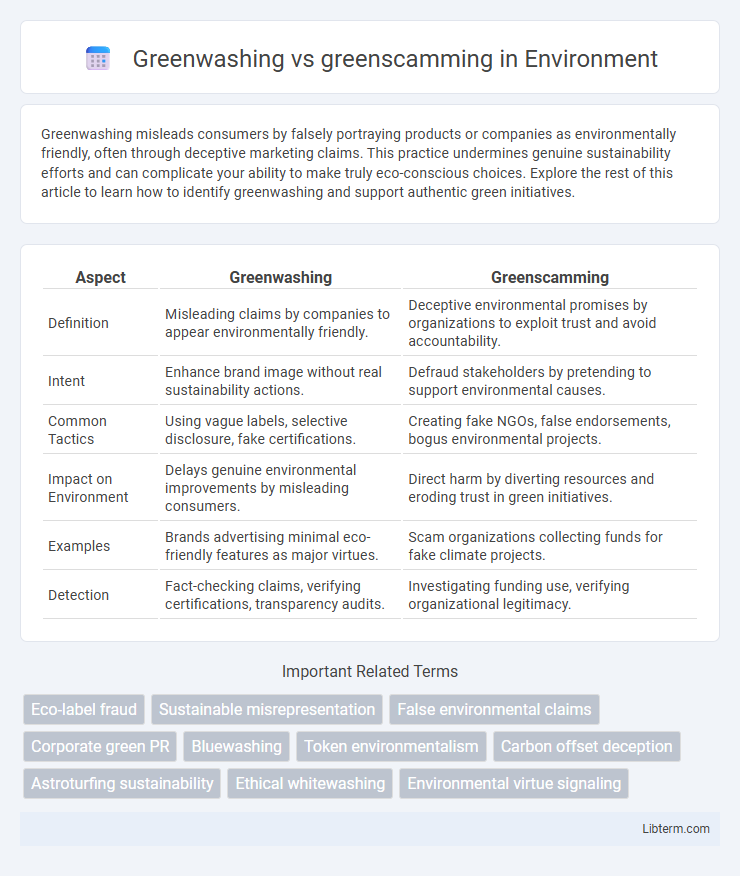Greenwashing misleads consumers by falsely portraying products or companies as environmentally friendly, often through deceptive marketing claims. This practice undermines genuine sustainability efforts and can complicate your ability to make truly eco-conscious choices. Explore the rest of this article to learn how to identify greenwashing and support authentic green initiatives.
Table of Comparison
| Aspect | Greenwashing | Greenscamming |
|---|---|---|
| Definition | Misleading claims by companies to appear environmentally friendly. | Deceptive environmental promises by organizations to exploit trust and avoid accountability. |
| Intent | Enhance brand image without real sustainability actions. | Defraud stakeholders by pretending to support environmental causes. |
| Common Tactics | Using vague labels, selective disclosure, fake certifications. | Creating fake NGOs, false endorsements, bogus environmental projects. |
| Impact on Environment | Delays genuine environmental improvements by misleading consumers. | Direct harm by diverting resources and eroding trust in green initiatives. |
| Examples | Brands advertising minimal eco-friendly features as major virtues. | Scam organizations collecting funds for fake climate projects. |
| Detection | Fact-checking claims, verifying certifications, transparency audits. | Investigating funding use, verifying organizational legitimacy. |
Understanding Greenwashing: Definition and Tactics
Greenwashing involves companies misleading consumers by falsely portraying their products or practices as environmentally friendly through vague claims, selective data, or deceptive imagery. Common tactics include green labels without certification, hidden trade-offs, and irrelevant environmental claims designed to create a false impression of sustainability. Understanding greenwashing requires recognizing these strategies to differentiate genuine environmental responsibility from superficial marketing efforts.
What is Greenscamming? Unmasking the Deception
Greenscamming is a deceptive marketing strategy where companies falsely promote products or practices as environmentally friendly to attract eco-conscious consumers and gain a competitive advantage. This tactic involves misleading claims, fake certifications, or exaggerated environmental benefits designed to exploit the growing demand for sustainability. Unmasking greenscamming requires critical evaluation of transparency, third-party audits, and genuine environmental impact assessments to differentiate authentic green initiatives from fraudulent ones.
Key Differences Between Greenwashing and Greenscamming
Greenwashing involves companies misleading consumers by promoting products or policies as environmentally friendly when they are not, often using vague or false claims. Greenscamming goes further by deliberately deceiving stakeholders through fraudulent or illegal environmental practices to gain trust or financial benefits. The key difference lies in greenwashing's subtle misinformation versus greenscamming's intentional, fraudulent exploitation of environmental concerns.
Common Industries Accused of Greenwashing
Common industries accused of greenwashing include fashion, automotive, and energy sectors, where companies often exaggerate eco-friendly practices to appeal to environmentally conscious consumers. Fast fashion brands frequently market "sustainable" lines despite significant waste and pollution, while automotive companies promote electric models without addressing broader emissions. Energy firms may highlight renewable projects but simultaneously invest heavily in fossil fuels, contributing to greenscamming by misleading stakeholders about their environmental impact.
How Greenscamming Manipulates Public Perception
Greenscamming manipulates public perception by using deceptive marketing tactics that falsely portray products or companies as environmentally friendly, creating an illusion of sustainability without meaningful action. This tactic often involves exaggerated claims, misleading certifications, or irrelevant environmental references that confuse consumers and undermine genuine eco-friendly initiatives. The result is consumer mistrust and diluted efforts toward real environmental progress.
Real-World Examples: Greenwashing vs Greenscamming
Greenwashing misleads consumers by exaggerating a company's environmental efforts, such as Volkswagen's 2015 emissions scandal where diesel engines were falsely marketed as low-emission. Greenscamming involves fake or deceptive environmental activism, exemplified by some front groups funded by fossil fuel industries to oppose climate legislation while masquerading as grassroots movements. Recognizing these tactics is crucial for consumers and policymakers to support genuine sustainability and avoid manipulation.
The Impact on Consumers and Climate Action
Greenwashing misleads consumers by promoting false environmental benefits, undermining trust and delaying genuine climate action. Greenscamming exploits green consumer enthusiasm through deceptive claims, diverting funds from authentic sustainability initiatives. Both practices hinder informed decision-making, weakening overall efforts to combat climate change and protect ecosystems.
Regulatory Responses and Legal Challenges
Regulatory responses to greenwashing involve stricter guidelines from agencies like the FTC and the EU Commission to prevent misleading environmental claims in advertising and product labeling. Legal challenges often center around consumer protection laws and false advertising statutes, with companies facing fines and lawsuits for deceptive practices that exploit environmental concerns. Emerging regulations increasingly demand transparent, verifiable sustainability data to combat both greenwashing and greenscamming, ensuring accountability in corporate environmental claims.
Tips for Spotting Greenwashing and Greenscamming
Identify greenwashing by looking for vague or unsubstantiated eco-friendly claims lacking third-party certifications like USDA Organic or Energy Star. Spot greenscamming through overly aggressive marketing tactics promising unrealistic environmental impacts without transparency or verifiable data. Reliable companies provide detailed sustainability reports, clear sourcing information, and measurable environmental benefits backed by credible audits.
Building Genuine Sustainability: Best Practices
Building genuine sustainability requires transparent communication and verifiable environmental claims to avoid greenwashing and greenscamming, which mislead consumers about eco-friendly practices. Implementing third-party certifications, measurable sustainability goals, and continuous environmental impact assessments enhances credibility and fosters trust. Prioritizing authentic resource conservation and social responsibility sets a solid foundation for long-term sustainable business success.
Greenwashing Infographic

 libterm.com
libterm.com